




Next: PROCESSING AS CONJUGATE TO
Up: Claerbout: Antialiasing with triangles
Previous: Claerbout: Antialiasing with triangles
In geophysical data recording there is usually
a local array whose elements are added locally
before a single channel is recorded.
For example, the SEP student group once laid out
more than 4056 geophones
which they grouped and added into 169 separate recorders.
We may think of the local superposition
as an integration over a small interval of space
to create a sampled space function from a continuous one.
With vibrator sources, it is also customary to vibrate on
various nearby source locations and sum them into a single signal.
Figure 1 is a caricature of what happens.
On the left a data field appears
to be a continuous function of space
(it is actually 500 spatial locations)
with various impulsive signals at different times and distances.
oversamp
Figure 1
Quasicontinuous field (left) added in groups (right).





For simplicity, all signals have unit amplitude.
The 500 signals are segregated into 10 groups of 50
and each group of 50 is summed into a single channel.
The various signals sum to functions
that could be called ``slump shouldered rectangles.''
If both x and t-meshes were refined further,
the ``slump shoulders'' on the rectangles would diminish
in importance and we would notice that the rectangles were still imperfect.
This is because the rectangle approximation
arises from the approximation that
the hyperbola is a straight line over the recording array.
In reality, there is curvature
and the effect of curvature is strongest near the apex,
so the rectangle approximation is poor at the apex.
Some of the rectangles are longer than others.
The narrow ones are tall and the wide ones are short
because the area of each rectangle must be 50
(being the sum of 50 channels each holding a 1).
Since the rectangles all have the same area,
were we to lowpass filter the recorded data
we would recover the original characteristic
that all these signals have the same amplitude.
If the 500 channels had been individually recorded
we could convolve them along the horizontal axis
with a 50 point long rectangle function.
The output could be sampled once every 50 points
to give the coarse-mesh data in Figure 1.
Convolving with a rectangle function of x
is dual to multiplying by a sinc function
 in the Fourier domain.
The sinc function has its first zero where
one wavelength of a spatial sinusoid
precisely fits inside the rectangle function.
When 49 out of 50 channels are abandoned
we have spatial aliasing (spectral folding)
of higher wavelengths into lower ones.
Mathematically, we would prefer
to have a rectangle in the kx-domain
which would erase the energy that would otherwise
be aliased to lower frequencies
and would preserve the lower frequencies without scaling them.
Thus Fourier transform theory implies
we should use the (unruly) sinc function
as a weighting function for the field operations.
As you might imagine, the subject of antenna design
is the subject of many patents that address
the fundamental issues in various ways.
in the Fourier domain.
The sinc function has its first zero where
one wavelength of a spatial sinusoid
precisely fits inside the rectangle function.
When 49 out of 50 channels are abandoned
we have spatial aliasing (spectral folding)
of higher wavelengths into lower ones.
Mathematically, we would prefer
to have a rectangle in the kx-domain
which would erase the energy that would otherwise
be aliased to lower frequencies
and would preserve the lower frequencies without scaling them.
Thus Fourier transform theory implies
we should use the (unruly) sinc function
as a weighting function for the field operations.
As you might imagine, the subject of antenna design
is the subject of many patents that address
the fundamental issues in various ways.





Next: PROCESSING AS CONJUGATE TO
Up: Claerbout: Antialiasing with triangles
Previous: Claerbout: Antialiasing with triangles
Stanford Exploration Project
11/18/1997


![]() in the Fourier domain.
The sinc function has its first zero where
one wavelength of a spatial sinusoid
precisely fits inside the rectangle function.
When 49 out of 50 channels are abandoned
we have spatial aliasing (spectral folding)
of higher wavelengths into lower ones.
Mathematically, we would prefer
to have a rectangle in the kx-domain
which would erase the energy that would otherwise
be aliased to lower frequencies
and would preserve the lower frequencies without scaling them.
Thus Fourier transform theory implies
we should use the (unruly) sinc function
as a weighting function for the field operations.
As you might imagine, the subject of antenna design
is the subject of many patents that address
the fundamental issues in various ways.
in the Fourier domain.
The sinc function has its first zero where
one wavelength of a spatial sinusoid
precisely fits inside the rectangle function.
When 49 out of 50 channels are abandoned
we have spatial aliasing (spectral folding)
of higher wavelengths into lower ones.
Mathematically, we would prefer
to have a rectangle in the kx-domain
which would erase the energy that would otherwise
be aliased to lower frequencies
and would preserve the lower frequencies without scaling them.
Thus Fourier transform theory implies
we should use the (unruly) sinc function
as a weighting function for the field operations.
As you might imagine, the subject of antenna design
is the subject of many patents that address
the fundamental issues in various ways.